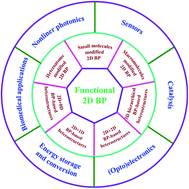Functional two-dimensional black phosphorus nanostructures towards next-generation devices
Abstract
In recent years, two-dimensional (2D) black phosphorus (BP) has been widely applied in many fields, such as (opto)electronics, transistors, catalysis and biomedical applications due to its large surface area, tunable direct bandgap, superior charge carrier mobility, and unique in-plane anisotropic structure. To exploit its full potential and push the limits, studies on functional 2D BP nanostructures fabricated by a variety of methods, such as surface functionalization and hybridization, are rapidly expanding for next-generation devices with unprecedented properties. In this review, firstly, the synthetic techniques and fundamental properties of functional 2D BP nanostructures, including surface-modified 2D BP nanostructures and mixed-dimensional 2D BP-based heterostructures, are systematically summarized. Secondly, the recent progress of functional 2D BP nanostructures in the fields of energy storage and conversion, (opto) electronics, catalysis, sensors, nonlinear photonics, and biomedical applications is highlighted. Last but not least, the challenges and future opportunities in these emerging areas are discussed. We hope that this review can provide fundamental guidance on new designs of high-performance functional 2D BP nanostructures to meet the growing demand of next-generation devices.



 Please wait while we load your content...
Please wait while we load your content...